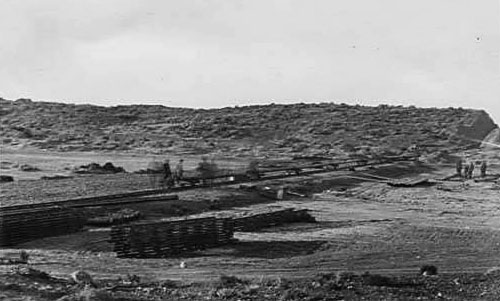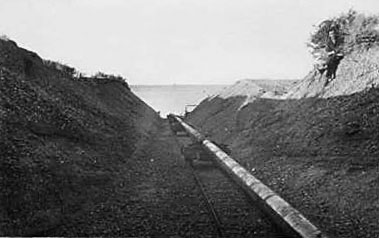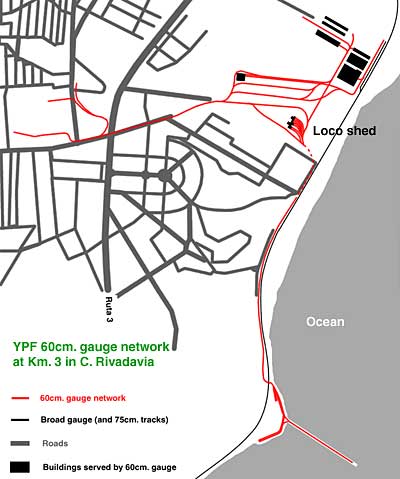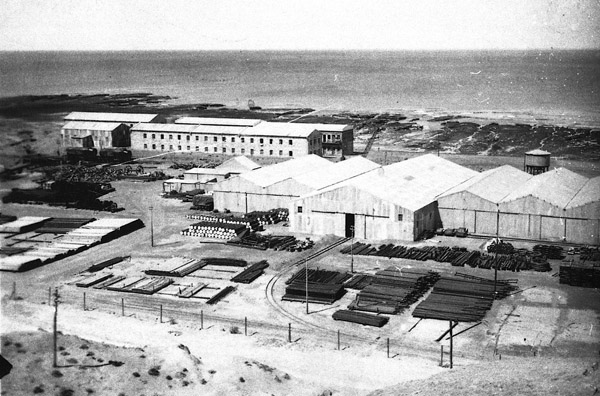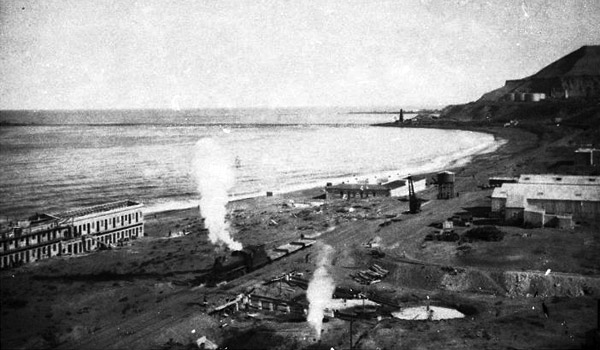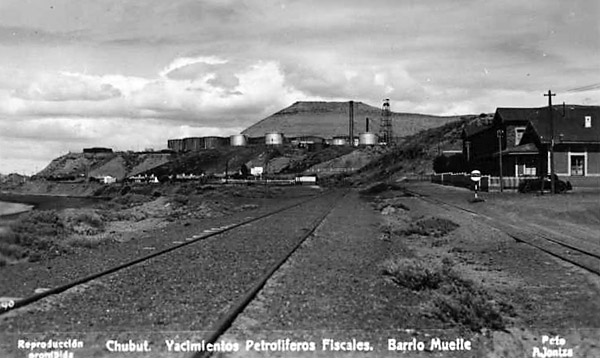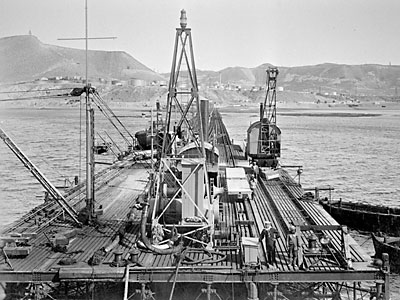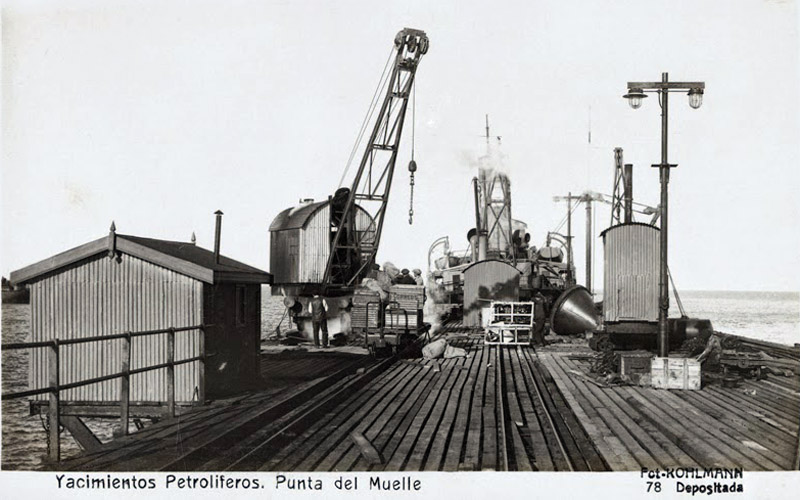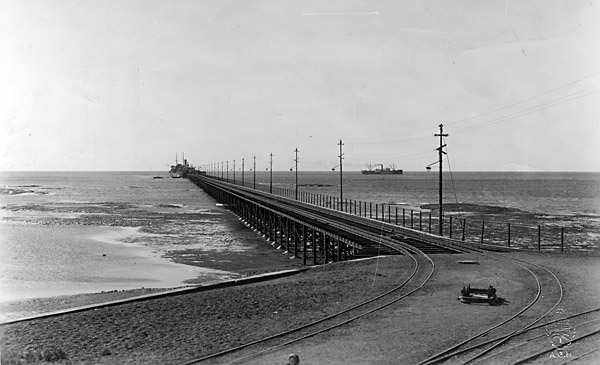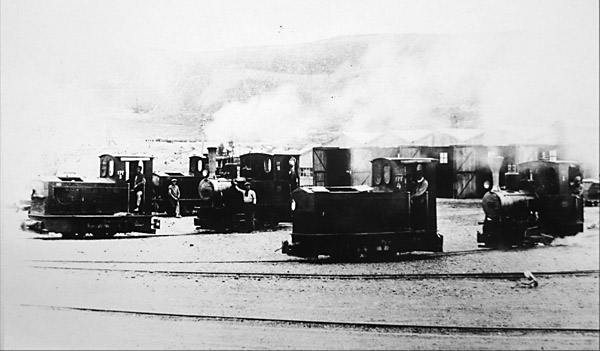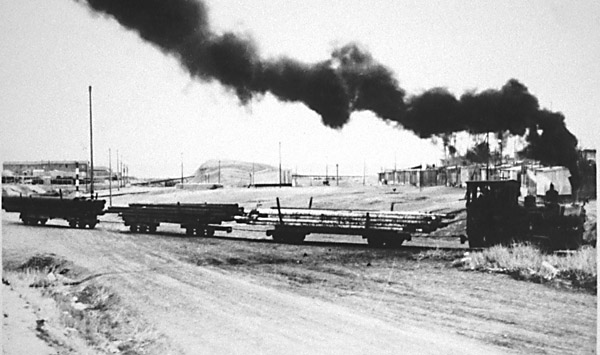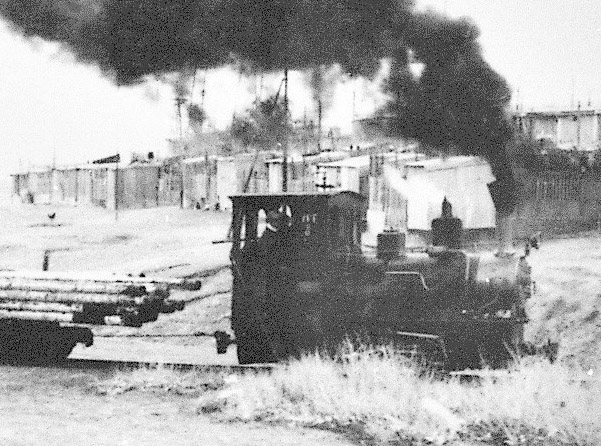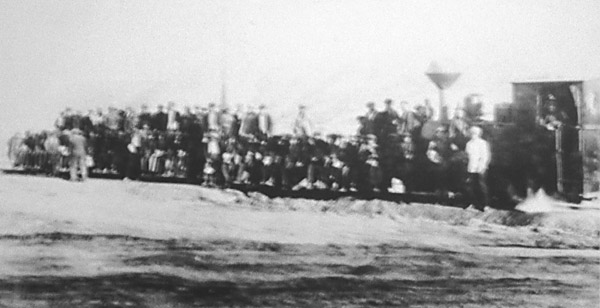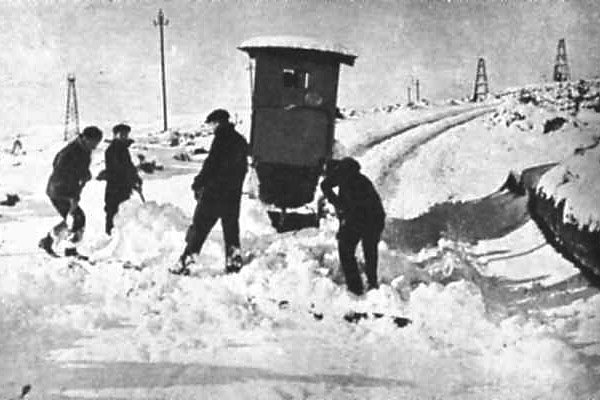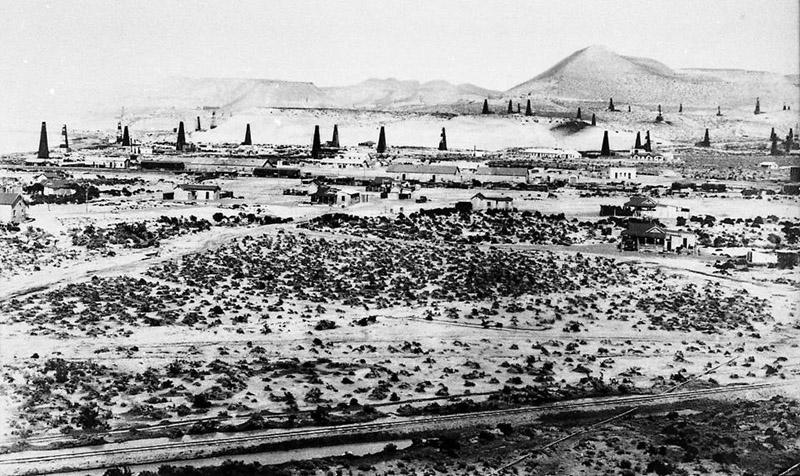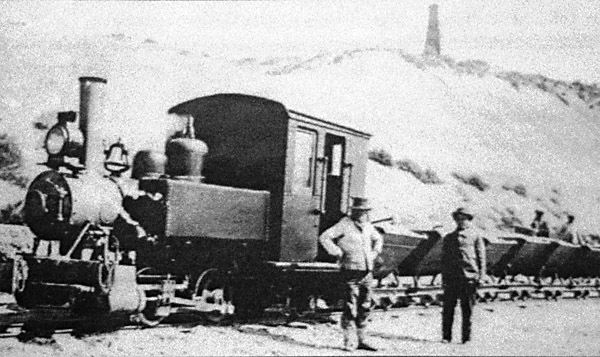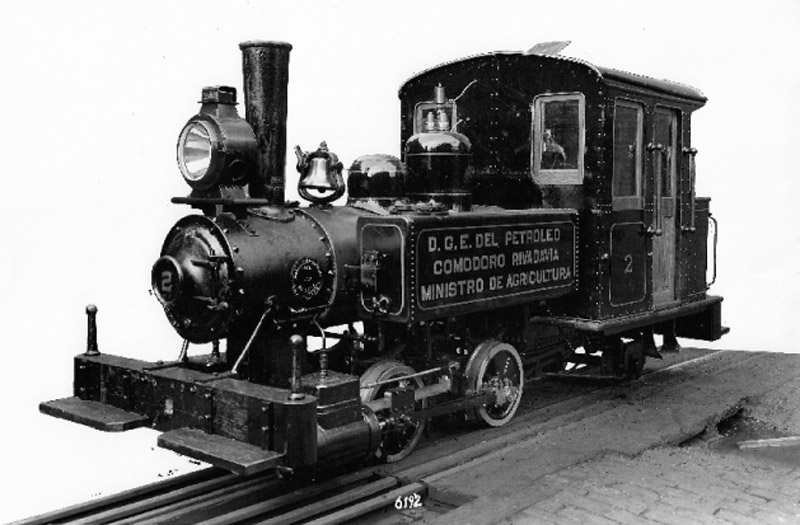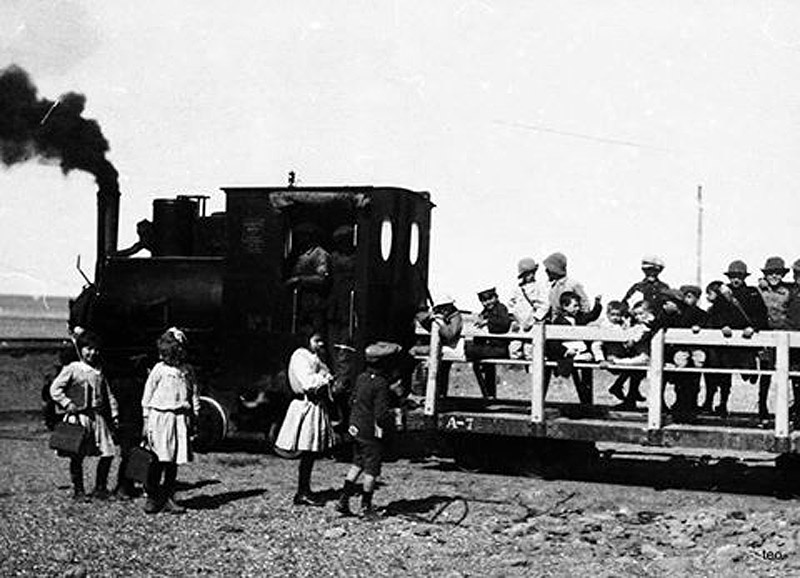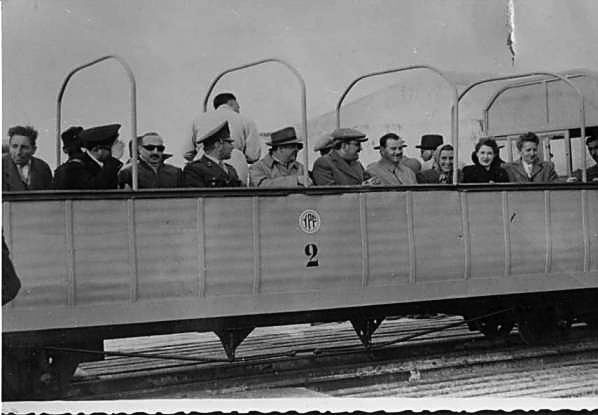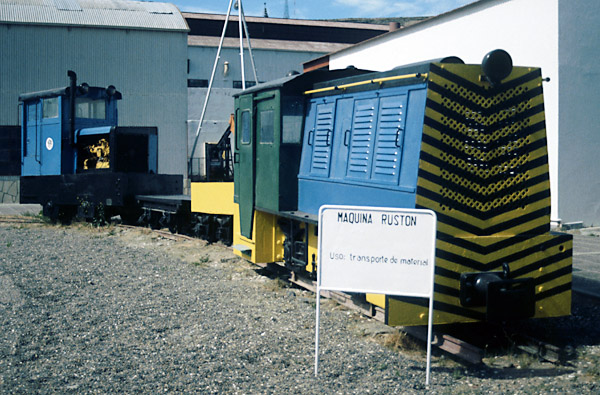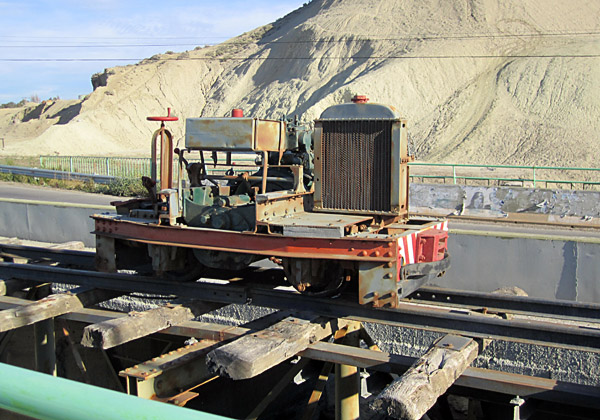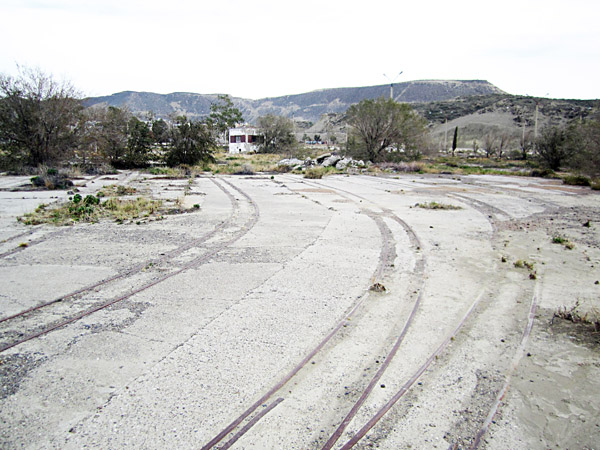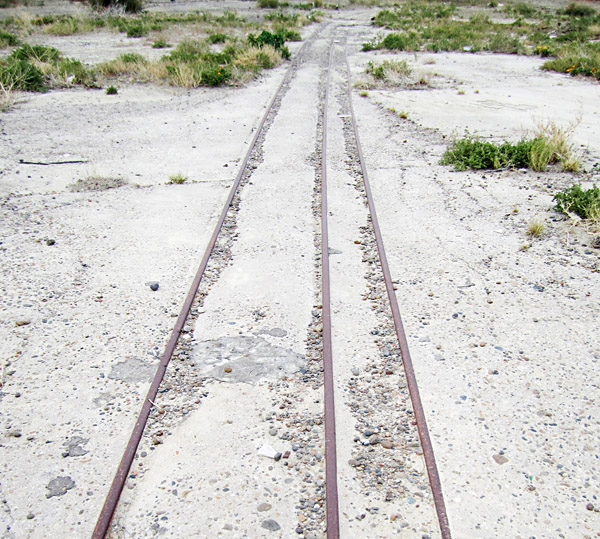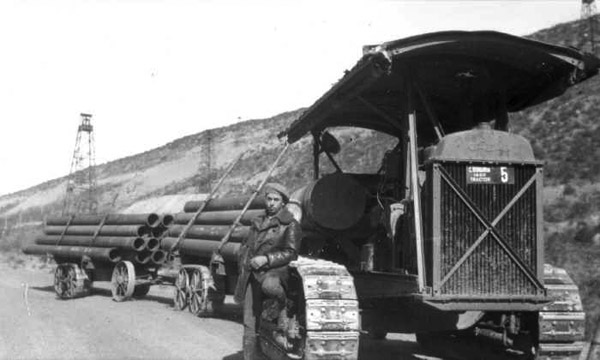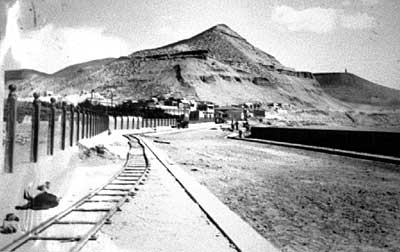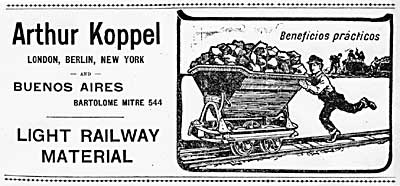 |
|||||||||||||||
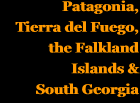 |
|||||||||||||||
 |
|||||||||||||||
 |
|||||||||||||||
Industrial lines around Comodoro Rivadavia Steam in the oilfields The northern system The following two photos, from the Dickinson College archive, show 60cm tracks and wagons carrying long lengths of pipe ready for laying (10). These are supposed to be near Caleta Córdova. This first one shows a trackbed with cutting and embankment, a stack of track panels, and a series of small four-wheeled trucks or bogies supporting a length of pipe.
The second photo from this source shows the bogies and pipe more clearly, in a cutting pointing directly towards what is presumably the sea (10).
The southern network The simplified map shown below covers about four kilometres from top to bottom. 1950s topographic maps discovered more recently show a far greater extent, stretching out north and west for up to five kms. See below for access to these maps.
The more detailed topographic maps dating from the 1950s are available on an appendix page. Click here to visit that page. Jorge Garreta Mendoza suggests that these depots also used several Ruston diesels, O & K steam, petrol & diesel locos and Schoema diesels. One of the latter is preserved in the oil museum though labelled as a Ruston. Along with it is also an American Brookville diesel. Further down this page is a picture of a preserved 20hp Simplex. It is likely that this too work in the oil industry. The system was centred on the YPF workshops at Km.3. This photo looks down on part of that complex (11). 60cm gauge tracks can be seen in the foreground, whilst broad gauge materials including a set of loco wheels and two 'Patagonico' tank wagons re to the left.
The following picture shows the same area from the north (11). The broad gauge mainline, with a pacific and three flats, runs parallel to the sea, whilst the 60cm gauge has run parallel with it from the long YPF muelle in the distance. The narrow gauge track makes a 90 degree curve in the foreground to enter the workshop complex.
The postcard below (by courtesy of Jorge Garreta Mendoza) shows the 60cm gauge track running alongside the broad gauge, facing south towards the YPF muelle location. There is strangely no sign of the 75cm gauge in this view, though if taken in the 1960s it might alreeady have been lifted.
A number of photos have come to light showing the YPF muelle at Km 3 (7). This one illustrates the seaward end of the muelle and displays a broad gauge crane on an isolated length of track as well as 60cm gauge flat wagons which have arrived via a double track along the length of the muelle.
This post card view of the same facility has been taken from the opposite direction. It shows the two tracks approaching from the shore and a third one just to the right of the lamp-post. There is an empty wagon on the left-most track and one lurking to the right of the lamp-post. (7A)
A second photo, like the one above found in the Archivo General de la Nacion in Buenos Aires, shows the double narrow gauge track along the muelle. At this point they are passing a broad gauge steam crane mounted on a higher platform isolated from any great length of rails.
This third photo shows the landward end of the muelle, with the tracks curving northward to the main YPF depot a kilometre or so away, and a triangle and sidings at this spot.
YPF locos and rolling stock This first YPF picture was taken in the southern system loco shed yard. Two 0-4-0T steam engines, almost certainly Orenstein & Koppels, are seen along with three early O&K Montania petrol locos (probably of class S1) (6). These latter locos date from around 1920-25. From left, the locos bear the running numbers 5, ?, 10, 4 and 1. Number 10 is clearly an 0-4-2T.
A train of materials crosses a road behind one of the little German steam locos.
An enlargement of the locomotive in the previous photo, showing it to be YPF N⁰ 3 or 5. The coupling to the first wagon does not look very rigid. One hopes that the wagons loaded with pipes did not overrun the loco. It rather looks as if the engine is fitted with an electric headlamp.
Another steam loco, this time with a spark-arresting chimney poses with a large number of men.
One of the O&K Montania petrol locos in the snow amongst a group of well heads. The lines of rails in the background are too far apart for 60 cm gauge but it is probable that the picture had been retouched by someone not expert in railways. Photo reproduced by courtesy of Señor Miguel Fiordelli. Narrow gauge line shown in landscape of snow-bound oil-field. (9A)
This picture is placed here merely by virtue of the oil derrick in the background. It may not have been connected to the oil industry. The loco appears to be a BDavenport 0-4-2T with a train of skip wagons. The photo appeared in a recent book on Comodoro Rivadavia's history, with the date 1928 attributed to it (1).
The following image shows the same engine in a Vulcan Iron Works builder's photo. It is clear from this picture that the loco was purchased by the YPF's predecessor, the Dirección General del Petróleo, Comodoro Rivadavia, which was the responsibility of the Ministro de Agricultura.
If the Vulcan was YPF no.2, then no. 1, below, seems to have been a Maffei 'combined fireless' loco, also an 0-4-2T. Combined fireless engines were fairly rare. They had a small conventional boiler surrounded by a cylindrical steam reservoir. Whilst the engine could work as s a normal loco, once the reservoir had been charged with steam the fire could be extinguished and the chimney sealed, so that the machine could then work for an hour or two in fireless mode.
This is a local passenger train taken in the 1940s. Apparently it operated between the muelle and the workshops and was used for the transport of shift workers and for children going to School No 2. It crossed under the broad gauge line in what was described as a “tunnel”.
While the engine crew have a cab and canvas screens to protect them from the winter weather, the passengers have nothing. (9A)
This photo shows an open coach for VIPs, presumably created from a bogie wagon. The date and circumstances are unknown (10)
Where once was the west end of the Km.3 network is now the Museo Nacional de Petróleo. In their grounds are a number of large oil industry relics. These two diesels - a Brookville and a Schoema despite the sign - are on display, as is a steam crane from the harbour.
Further north, on the way to Km. 5, a 20hp Simplex is plinthed on the remains af a bridge between the two carriageways of the coastal highway. This should at least reduce the risk of vandalism.
At the core of the southern network around Km3 was a very large YPF depot, between Ruta 3 and the coast. This is now largely empty and derelict (2011) but a number of relics of the narrow gauge system remain in place particularly where the tracks were concerted over. At the hub of the system was the loco shed and yard, whose fan of tracks can be seen on the map above. Amazingly, sixty years after the abandonment of the system, all the tracks survive in 2011 and the full layout has been traced and drawn out.
One of those tracks has a third rail for several yards (below), giving a larger track gauge of around 90cm. All three rails curve in unison, reducing the possibility that this is a coincidence. Anyone knowing anything of 90cm or 3 foot gauge operations in the area is invited to get in touch with Martin Coombs or David Sinclair (see Homepage for details).
There remains scope to find out a lot more about these oil lines. Finally, to illustrate the sort of competition these oilfield railways were up against, here is a picture of an early Caterpillar Sixty crawler tractor hauling pipes (8).
Unknown locations
Another line of 60cm gauge contractor's track, possibly in Barrio Km. 3.
References: Anyone interested in old photos of Comodoro Rivadavia should also visit Miguel Fiordelli's website. A number of his photos are of railway interest and almost all can be viewed in larger sizes by clicking on the thumbnail pictures.
An Arthur Koppel advert from an issue of The Review of the River Plate in 1906. 29-1-2018 |
|||||||||||||||
Chapter 13
A variety of industrial railways


